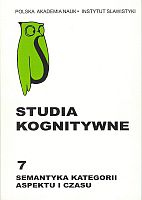Temporal expressions in Petri nets representation
Temporal expressions in Petri nets representation
Author(s): Natalia KotsybaSubject(s): Language and Literature Studies
Published by: Instytut Slawistyki Polskiej Akademii Nauk
Summary/Abstract: Petri nets, originally devised for informatics needs and introduced in 1962 by [Petri], were proposed in 1986 by [Mazurkiewicz] as a possible formalism for representing temporal and modal meanings of natural languages. Theoretical account of their application for natural languages is presented in detail in Koseska-Toszewa [1996] and other works of that author. It has been demonstrated efficiently in numerous papers by Koseska-Toszewa and/or Antoni Mazurkiewicz that Petri nets can be a good illustration of the way humans conceptualize what happens around them. The nets help us visualize the core meaning of such semantically complex grammatical meanings as the (Bulgarian) Perfectum and other tenses, as well as modality and quantification.
Journal: Cognitive Studies | Études cognitives
- Issue Year: 2006
- Issue No: 7
- Page Range: 189-207
- Page Count: 19
- Language: English

